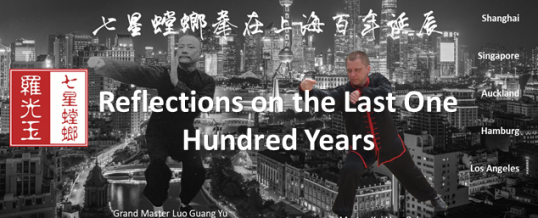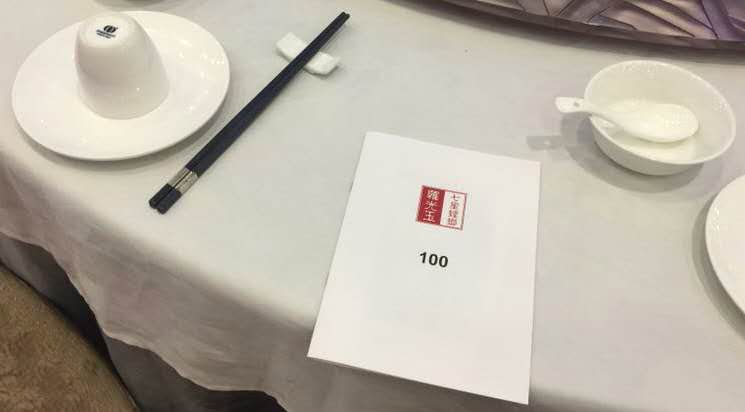
This year June 8th 2019 we celebrated our teacher’s birthday in Shanghai. Master Kai Uwe Pel of the Seven Star Praying Mantis style came to Shanghai to teach from 2002, first with the surviving Jing Wu organization, then at the Longwu Center and privately in the suburb Xin Zhuang. We identify our schools with the great grandmaster Luo Guang Yu and name our modern clubs Luo Guang Yu Seven Star Praying Mantis. This year also marks a hundred years since Luo Guang Yu came to teach in the original Shanghai Jing Wu school, bringing the style from Shandong province and ultimately giving it to the world.

Seven Star Praying Mantis originated in the Shaolin Temple and most Mantis schools and styles begin with the legend of Wang Long, a student in the temple who devised the style. The monk Bodhidharma visited Luo Yang and then Mt. Song by the temple around 500 CE and taught the monks yogic techniques known as the Luohan Movements. These were combined with martial arts to form a unique style that Chinese scholarship notes as being nationally acknowledged in the reforms of the emperor Song Taizu in 960 CE. Wang Long existed sometime between then and when the Seven Star style surfaces in modern record keeping, in 1800s Shandong.

The mantis fighter Li Sanjian is said to have learned directly from the monastic line, from a temple in the Laoshan Mountains. He then taught Wang Rongsheng who came from a rich family and was able to open a school. His most famous student was Fan Xudong, who was known for his large size and fighting ability. Fan had five master students: Luo Guang Yu, Lin Jingshan, Yang Weixin, Guo Jialu and Wang Chuanyi. Fan was invited to teach in the Shanghai Jingwu school but was already elderly and sent Luo Guangyu as his official representative.
As one of the Four Superlords of Jingwu, Luo surprised many and shook things up. The Jingwu project was born in a time where confidence in Chinese culture was at a low in the face of colonialism and social upheaval. Luo and his kungfu brothers were from Fan Xudong’s tradition with a high level of technical skill, iron palm training, and a reputation for never shirking a real fight. An early boost to the school came when one of Luo’s students scored wins in a Leitai free fighting competition. Even more telling is an anecdote from Mantis Master Huang Hanxun (Wong Honfun), writing in his book on the Tiger Tail Three Section Staff. He relates how the three-section-staff was considered to be outside of the main training and passing-the-time, but when Luo Guangyu came to the Guangzhou Jingwu to teach they all realized his high level of skill before he even finished playing the first set, the implication being the issue was with them, not the weapon itself.
Luo Guangyu brought the style into the general public eye and led by example, showing that it was practical and strong. Shanghai also had modern mass media and the other effect was the standardization of the style, or rather a more robust record-keeping of the traditions. Whether a school strives to follow his example, or defines themselves by their difference to him, Luo Guangyu is the most accomplished Seven Star Grandmaster and the measuring stick for our family.
Master Kai Uwe Pel first trained in Hong Kong under Master Lee Kam Wing (Li Jin Rong). His teacher, Master Zhao Zhi Min, had taught at Hong Kong Jingwu and had studied under Luo Guangyu with Huang Hanxun. Having completed his training and graduated the full system, Pel continued to train under Master Koh Kim Kok (Xu Jin Ge) in Singapore. Xu’s teacher was Master Lin Bo Yan, who trained directly in Luo Guangyu’s Shanghai class. Lin and Xu were both natives of Fujian province and Lin left the mainland during the turmoil of World War Two. Pel strove to emulate Lu Guangyu, leading by example with a high level of technical skill and physical performance, and becoming accomplished in the iron palm conditioning.
Master Pel first brought the style to his native Germany, setting up a lasting legacy that continues today. He came to Shanghai following a connection between the Singapore and Shanghai branches of the Jingwu school. Despite running a large public class open to all, the trend among the Shanghai public was towards boxing and Karate, with little support coming from the Jingwu, who leant on the Modern Wushu sport and had retired the traditional masters. However, a group of dedicated students pushed through and the family continues to be represented by Teacher Nathan Wright in Shanghai, as well as Teacher Cameron Hirst, who returned to his native New Zealand.

Recklinghausen, Germany
Writing this in Shanghai, looking out of the window, the old buildings of pre-war Shanghai are still visible everywhere. Using a tablet computer and a wireless connection to the internet, I look at the black and white photos of Luo Guang Yu performing the famous Beng Bu set in the Shanghai Jingwu. My main memory of our early training with Master Kai echoes the story of Huang Hanxun. All our doubts were cleared when we first saw Kai perform Beng Bu. Before he’d finished the form we were not only convinced of his ability but of the whole system, and it was us who would have to work very hard to get there. A hundred years seems like an age, but in many ways it’s a very short journey. Kai Uwe Pel met Zhao Zhimin, his Shigong, in Hong Kong and Zhao Zhimin was taught directly by Luo Guangyu. So, in celebrating with Master Kai in Shanghai this year, we honor our teacher, and also contemplate the traditions and the legacy we are a part of.
Andy Best, Student of Master Kai Uwe Pel.
Shanghai 2019
Recollections
After moving to Shanghai I began training in modern Wushu. Being young and not knowing so much about the martial arts I didn’t understand the history or background of what I was learning and that it was not a true reflection of the traditional arts. The Seven Star Praying Mantis class trained at the same time, next to where we trained. I saw them doing line drills, physical exercises, two-man drills, body conditioning, applications, forms and more weapons than I knew existed. I didn’t understand everything I saw them do, but I knew it was traditional and I knew it was comprehensive.
Master Kai was very friendly, and he and his students would always encourage me to come train with them, or even just join for a meal after training. Seeing the hard physical training and the strong group cohesion I knew I wasn’t receiving in the modern Wushu training convinced me. Within a few months of starting in the modern wushu, I had moved to the Seven Star Praying Mantis class. I immediately took to Master Kai’s methods as he had a clear structure and way of teaching. He was demanding but also rewarded those who put in the effort, I knew I would get out what I put in, and that there were no shortcuts.
After a short time training, I remember Kai demonstrated a section of a form we had begun learning. I had seen him perform movements or sequences for us to learn before, but always in a way we could follow. This time he performed the movements with real speed and power, and it was a lightbulb moment for me. I realised after seeing his blur of movements that my way of thinking about martial arts even physical training was wrong, and it was actually possible to be not only lightning fast, agile and fluid, but also strong and powerful at the same time. I had never seen those attributes all melded together, and I remember thinking, Oh, that’s what real Kung Fu is.
Having the chance to experience real Kung Fu due to Master Kai’s ability and the sense of community he built is what has kept me motivated and training until now. The high bar he has set means I know I have a lifetime of training to try and achieve it, and for that I am extremely grateful.
Cameron Hirst, Student of Master Kai Uwe Pel.
Recollections
Dedicating more than forty years of his life to the mastery and preservation of Seven Star Praying Mantis Kung Fu, Master Kai Uwe Pel to this day remains a shining example of what traditional Chinese martial arts is all about. Attaining the highest level of skill, he proudly represents his style with passion, humility and respect, while taking an intelligent no-nonsense approach to the fighting art.
My first meeting with Kai was in the Spring of 2003. At that time I was in search of a traditional Chinese Kung Fu teacher, and Kai had recently arrived in Shanghai. We exchanged a series of emails and one day he graciously invited me to his home where we sat at his dining room table, drank tea, and talked about Kung Fu. Despite my embarrassingly inept and awkward moments, Kai remained incredibly kind, humble, and generous in his exchange. He even went so far as to demonstrate the form Hei Hu Jiao Cha which completely blew my mind, and convinced me this was for real.
Over the last fifteen years Kai has impressed on me many lessons and knowledge in Seven Star Praying Mantis Kung Fu and I will forever be grateful to him as my teacher. Going forward I still have a long way to go and a lot to learn, but I will always do my best to represent him, the values he holds, and the greater traditions of our Luo Guang Yu Seven Star Praying Mantis family.
Nathan Wright, Student of Master Kai Uwe Pel.

Master Pel with Shanghai students, 2008
JUL
2019
